|
1955 - Spartans and Cadets.
As already discussed, several of the airfield staff and instructors were accommodated in three caravans on the north side of the airfield. As the pressure on post-war housing was unrelenting, permission was sought for a fourth to be sited in 1955, but this was refused initially. The airfield was still L shaped, but as can be seen in the photo below, the landing area was more than sufficient for most light aircraft of the day, even with Wimpey's cricket pitch still resident in the north-east corner.
|
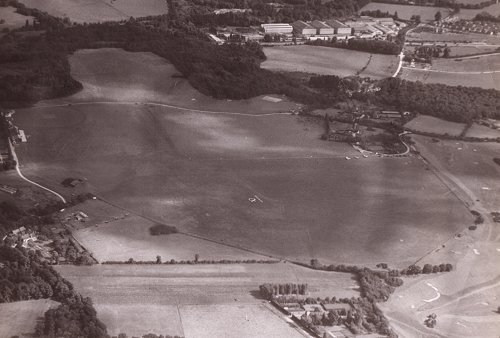
Denham Aerodrome in 1955, looking east. The cricket pitch can be clearly seen in the north-east corner.
|
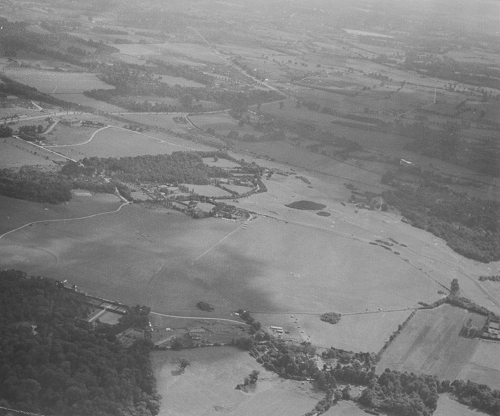
Denham Aerodrome in 1955, looking south east. Note the absence of houses in Denham Green.
|
The Denham Flying Club was operating a mixture of Miles M.14A Hawk Trainer IIIs and Austers of various types. One of the Miles M.14As, G-AJZH, had been jointly owned by three of the founders of the Denham Aero Club, Messers McNamara, Milli and Piri, who purchased it in January 1950. This was transferred to the Denham Flying Club in September 1953, then repainted into a new green and silver scheme in 1955. The aircraft was to continue with the club before it was written off in an accident in January 1958.
|
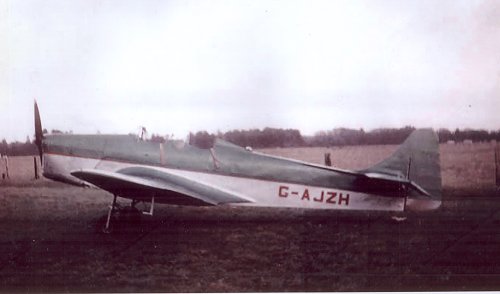
Miles M.14A Hawk Trainer III G-AJZH in a rare colour photograph after its 1955 repaint.
|
The Denham Flying Club also acquired a new Auster J1N Alpha in September, G-AGVJ, purchased from Mitchell Aircraft Ltd of Portsmouth. Built in 1945, it was to remain with the club until July 1963, and was to be flown by two more private owners until being eventually permanently withdrawn from use in 1971. Austers were popular with both students and clubs, being relatively easy to fly and cheap to operate. The cost of a one hour flying lesson in an Auster in 1955 was £1 17s 6d, or £1.87½p in modern money. Remember, this price included the fuel, the maintenance costs, the depreciation on the airframe and the instructors salary!
|
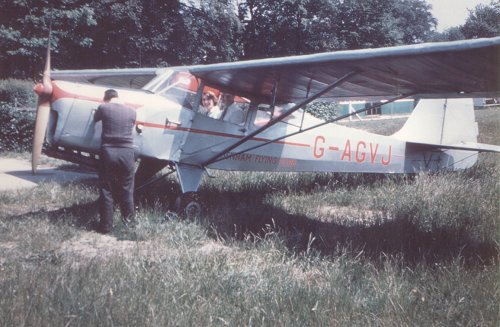
The Denham Flying Club purchased a new Auster J1N Alpha in September 1955, G-AGVJ.
|
Another remarkable aircraft came to Denham in March 1955 in the form of G-ABWP, a Spartan Arrow built in 1932. The first registered owner of the aircraft was Richard Shuttleworth, founder of the now world famous collection of vintage aircraft and vehicles based at Old Warden airfield in Bedfordshire. After passing through several private owners post-war, the Arrow was purchased by Messers Green, Bootle and Sweeting on 15 March 1955, who founded the Spartan Flying Group at Denham based around the aircraft. Interestingly, the aircraft is still flying today, owned by Ruchard Blaine, who still displays the Spartan Arrow occasionally at Shuttleworth's air shows. Like their aircraft, the Spartan Flying Group also still exist, nowadays flying a de Havilland DHC.1 Chipmunk, G-ATHD, also still based at Denham.
|
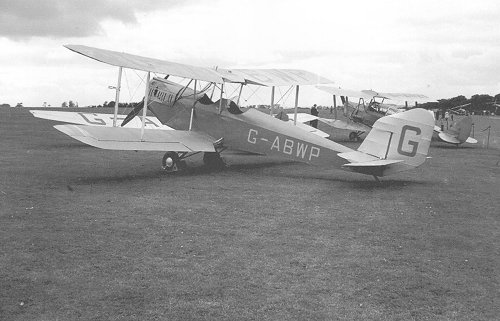
Spartan Arrow G-ABWP photographed at Denham in 1955.
|
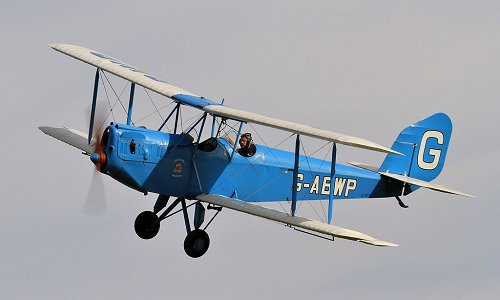
Spartan Arrow G-ABWP seen at a Shuttleworth Air Show in 2017.
|
Since their Chiltern Hill Air Race meeting the previous year had been a success, the Vintage Aeroplane Club (VAC) organised a Garden Party and Air Rally in co-operation with the Denham Flying Club on 24 July. The rally attracted sixteen entrants who had to fly a course to Portsmouth and return via six designated points, the whole flight having to be made at a specific groundspeed, points being lost for either early or late arrival at the turning points and back at Denham. While the aircraft were away flying the course, there were a variety of aerobatic, formation and vintage aircraft displays, as well as a parachute drop and model aircraft display. Ranald Porteous demonstrated the Auster Aiglet as he had in 1954, and David Ogilvy flew an aerobatic display in the Comper Swift. The whole day ended with a dinner dance at what is now Biggles restaurant on the south side of the aerodrome. Sadly, this was to be the last VAC event as the following year the club fell into decline. However, the VAC was to be resurrected in 1963 and the events they held were to start a series of airshows at Denham, having proven the viability of the aerodrome as a display venue. The programme for the 1955 event is reproduced below and again exhibits a certain tongue in cheek sense of humour, particularly in reference to the club's bank manager.
|
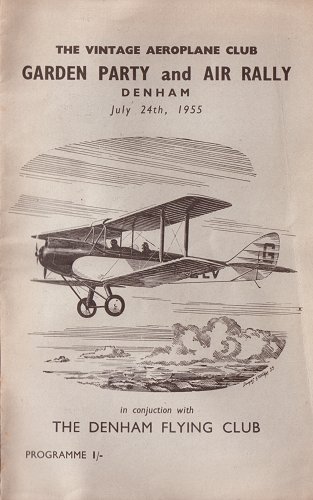
The Vintage Aeroplane Club programme for their Garden Party and Air Rally.
|
|
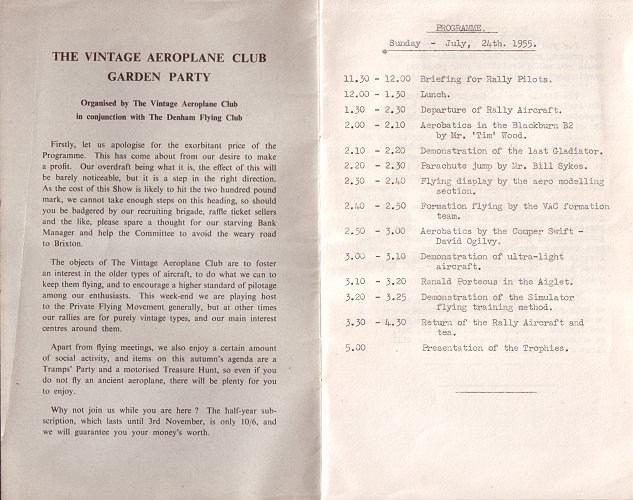
The Vintage Aeroplane Club programme for their Garden Party and Air Rally.
|
|
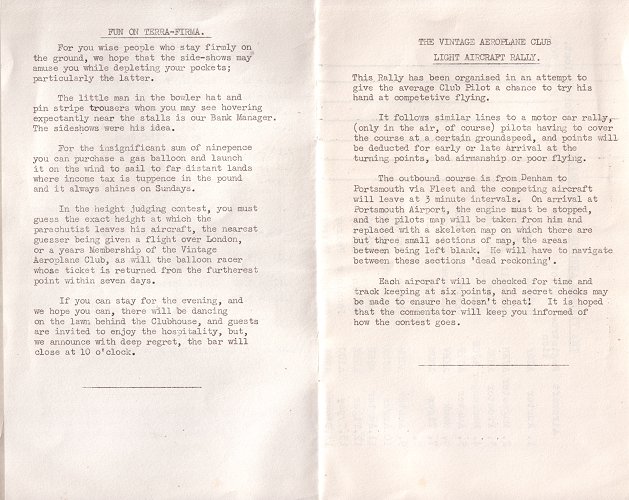
The Vintage Aeroplane Club programme for their Garden Party and Air Rally.
|
|
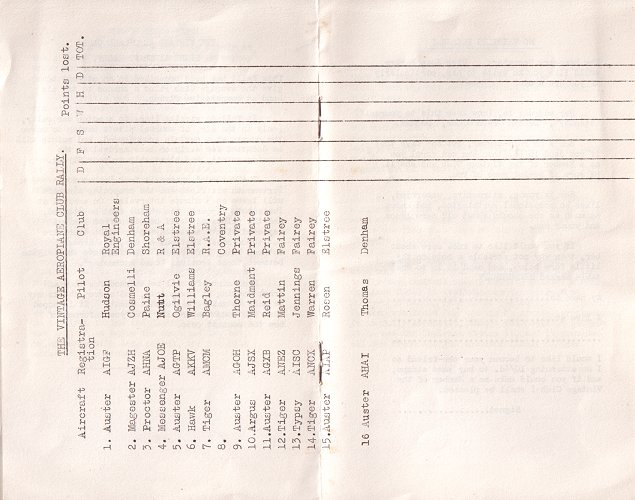
The Vintage Aeroplane Club programme for their Garden Party and Air Rally.
|
|
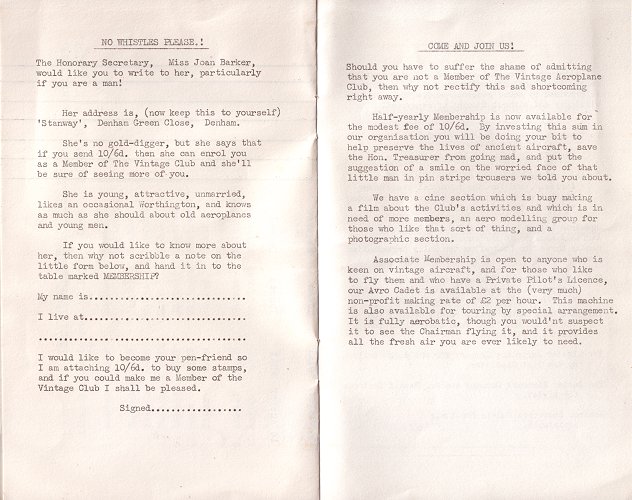
The Vintage Aeroplane Club programme for their Garden Party and Air Rally.
|
|
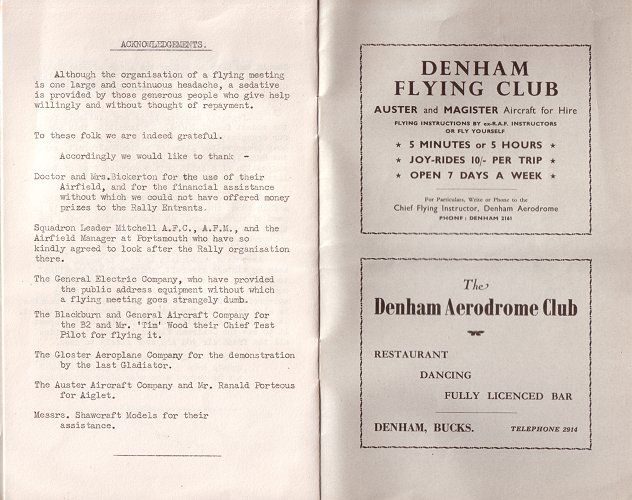
The Vintage Aeroplane Club programme for their Garden Party and Air Rally.
|
|
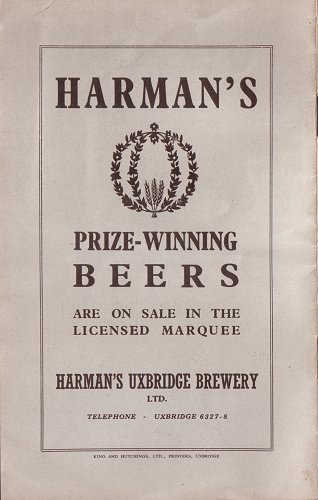
The Vintage Aeroplane Club programme for their Garden Party and Air Rally.
|
The Air Training Corps has a long association with Denham, one of their gliding schools being based on the aerodrome during the Second World War, and 2370 (Denham) Squadron ATC still being part of the airfield today. The Royal Air Force had provided flying training to the Air Training Corps since its foundation in 1941.
|
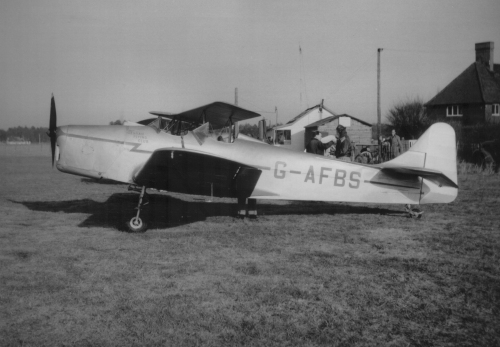
The Air Training Corps awarded scholarships at civilian flying schools in the 1950s. The Denham Flying School used such aircraft as G-AFBS for cadet flying.
|
After the war's end, the need for military pilots increased during the 1950's so the flying scholarship scheme was expanded to allow approved civilian flying schools to provided cadet training. The Denham Flying Club was one such school, chief instructor Derek Wright was himself an ex-RAF instructor so understood the requirements of military flying training.
|
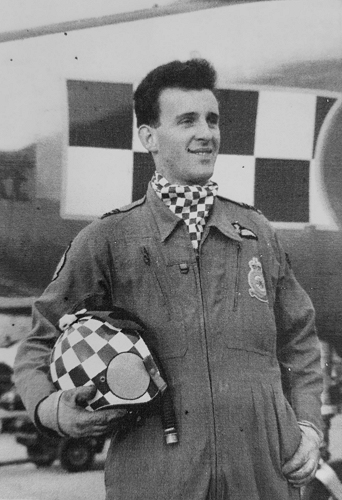
Brian Cheater won an RAF scholarship and gained his PPL at Denham. He is seen here with the aircraft he went on to fly in the RAF, the mighty English Electric Lightning.
|
One of the cadets who trained at Denham was Brian Cheater in 1955. He passed the selection process in 1954, winning a scholarship for 30 hours flying. Cadets were expected to learn to fly and achieve a Private Pilot's Licence in that time. Brian started the course the following year in his school holidays, his instructors were Derek Wright and Eric Pope. On the 2 August 1955 he made his first solo flight in the Miles Hawk Trainer III, G-AFBS. This aircraft survived many students and has earned well deserved retirement in the Imperial War Museum, Duxford. By the 20 April 1956 Brian had finished his hours and was awarded his PPL, No. 44298, at the age of 17. He was an exceptional pilot, being one of the few who went on to fly the Hawker Hunter and English Electric Lightning, eventually becoming a member of the 56(F) Squadron aerobatic team, the Firebirds. He retired in 1976 to become the Assistant Director of Birmingham Airport.
|
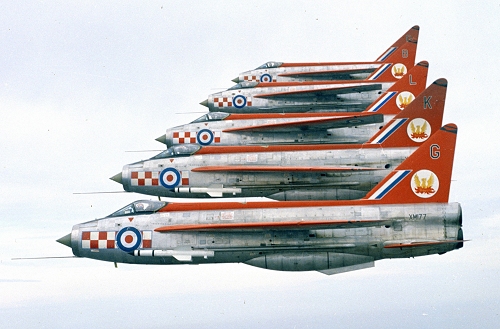
Brian was also a member of the 1963 Firebirds Aerobatic Team from 56(F) Squadron, flying displays all over Europe.
|
Speaking of airports, it is worthy to note that at this time, the growing importance of Heathrow and Northolt as civil and military air transport hubs was having an effect on the airspace available for use by aircraft arriving and departing from Denham. The history of the development of British Air Traffic Control System and the London Airports is a complex one, but suffice to note that construction of Heathrow had begun in 1944 and by 1946 the Ministry of Civil Aviation reported that both Heathrow and Northolt were handling over 50 flights a day, such was the demand for air transport. 1946 also saw the establishment of the first post war air traffic control systems with control areas and zones inside of which there were published procedures that aircraft had to conform too. One of these was the Metropolitan Control Zone (MCZ), 24 miles in radius and centred on Westminster Bridge. The MCZ was equipped with Non Directional radio Beacons (NDBs) to allow pilots to accurately fix their position and report to air traffic controllers. By 1947, both Heathrow and Prestwick were equipped with the first civil Ground Controlled Approach (GCA) radars which required the establishment of approach paths to the airports. The airspace over the UK was also divided into five Flight Information Regions (FIRs), the South Eastern FIR was based at Uxbridge at the former Battle of Britain 11 Group Control Station. In 1948, all the major airports in UK had a control zone with a radius of eight miles established around them to protect arriving and departing traffic. This meant that Denham was actually inside the Heathrow Control Zone by a mile, and within that of Northolt by four miles! Procedures were agreed to allow traffic to access Denham and other airfields that fell within the new zones. The next major step forward was in 1950 when London Radar became operational at Heathrow and the first European airway, Green One, was established from Strumble Head in Wales to Woodley, just south of Reading. This airway was to protect transatlantic traffic between Europe and the US. This first airway was to be followed by five more in 1951, linking London with Paris and Amsterdam and alowing traffic to fly around the London Control Zone, which was increased in size to cover the area at the junction of the new airways.
|
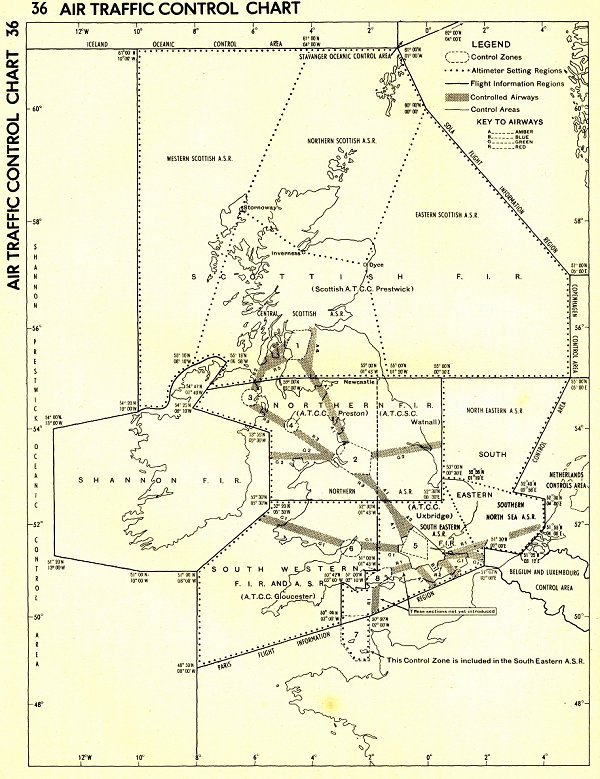
A UK Air Traffic Control Chart from 1951. Note area 5, the London Control Zone at the junction of the new airways.
|
Finally, in 1955, with Gatwick officially named as London's second airport and Croydon Airport about to close in the next two years, the Southern Air Traffic Control Centre moved from Uxbridge to Heathrow along with its area radars and comprehensive radio coverage. From this point onwards, the regulation of flying in the Denham area was to become increasingly subject to procedures to avoid controlled airspace resulting in the safe and simple system still in use today.
|
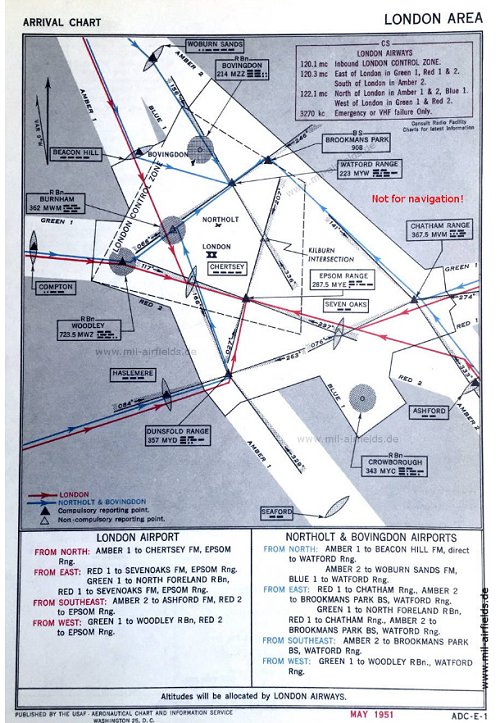
A United States Air Force Arrival Chart for the London Area created in May 1951, showing a close up of the expanded London Control Zone.
|
With the Airways Aero Club beginning to move to Croydon but the Denham Flying Club expanding, both civil and Air Training Corps flying training at Denham meant the instructors were fully employed. Further changes were to affect the aerodrome, as will be related next.
|
|

